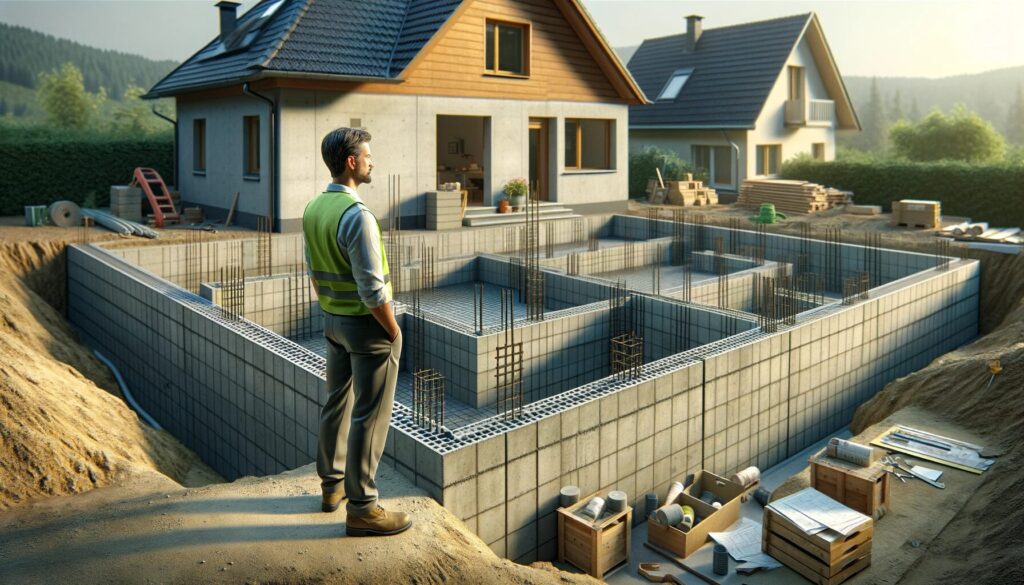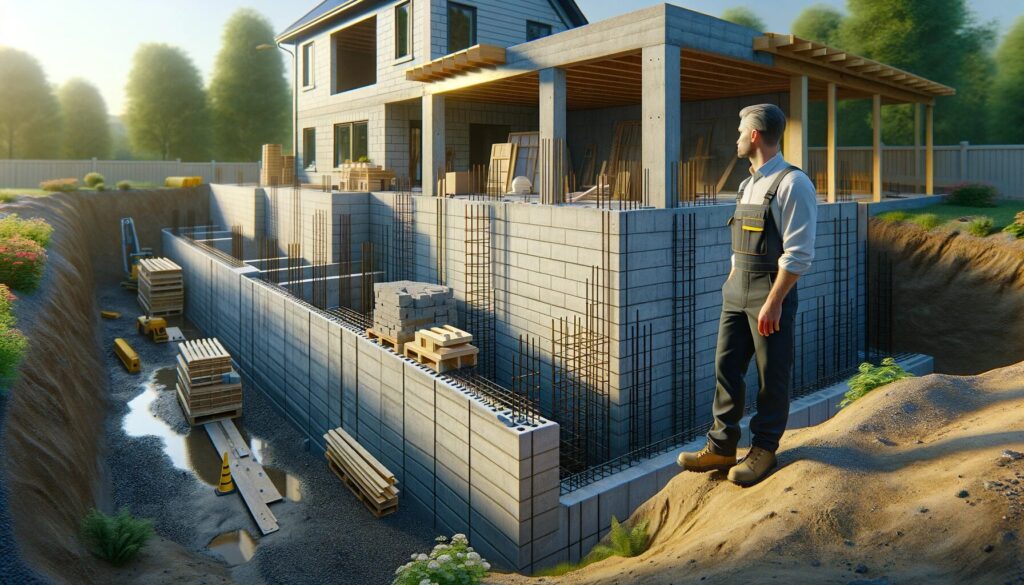In the world of home construction, laying a solid foundation is akin to setting the stage for a grand performance. It’s the unsung hero of your home, quietly doing its job day in and day out, keeping everything stable and upright. This guide is a tool for those who wield hammers on weekends and for the hard hats who build dreams from the ground up.

The Role of Foundations in Home Building
The foundation is more than just the underbelly of your home. It’s the barrier between your living space and the whims of nature. It’s what keeps your floors level, your walls crack-free, and your basement dry. But, like a good suit, there’s no one-size-fits-all. The foundation you need depends on where you live – the local climate and the type of soil under your feet. It’s about making the right choice, like picking the right tool from your belt.
Main Types of House Foundations
Slab-on-Grade Foundations
Picture a thick concrete slab, laid directly on the ground – that’s your slab-on-grade foundation. It’s as straightforward as it gets.
- Pros: In warmer climates, where the ground stays docile all year round, these foundations are a boon. They’re cost-effective and quick to construct.
- Cons: However, they have their Achilles’ heel – in frost-prone areas, they’re susceptible to cracking as the ground heaves.
Crawl Space Foundations
Imagine a space under your house just high enough to crawl through. This gap, typically a few feet high, separates your home from the ground.
- Pros: It’s a practical choice for damp areas or places with termite issues. It gives easy access to plumbing and wiring – a handy feature for repairs and upgrades.
- Cons: But beware, these spaces can harbor moisture and mold if not ventilated properly. They need a keen eye for maintenance.
Basement Foundations
A basement foundation is like adding a sub-level to your home. It involves excavating a hole deeper than the frost line and then building concrete walls to form a basement.
- Pros: Basements offer extra space – a boon for storage or additional living area, and they naturally insulate your home in colder months.
- Cons: The catch? They’re more expensive and aren’t suitable for areas where the water table sings a high note.
Pier and Beam Foundations
Visualize your home perched on piers or pillars with beams spanning across them for support – that’s the essence of a pier and beam foundation.
- Pros: Ideal for uneven terrain or regions where the soil expands and contracts like an accordion. They provide a safeguard against flooding.
- Cons: However, the space beneath can attract wildlife and must be well-ventilated to prevent moisture issues.

Choosing the Right Foundation for Your Home
In my many years of building and renovating homes, I’ve come to understand that selecting the perfect foundation requires careful consideration, much like choosing the best materials for a long-lasting project. Here’s what to keep in mind:
- Geographical Location: Your foundation should match your location. In colder regions, consider a deeper foundation to prevent frost heave, similar to how you’d choose insulation for winter conditions. In hurricane-prone areas, your foundation needs to withstand potential flooding and high winds.
- Soil Type: The soil’s characteristics are crucial. Sandy, clay, or rocky soils each demand different foundation types. This decision is akin to selecting the right shoes for different terrains.
- Home Design: The design and size of your home influence the foundation choice. Larger, heavier structures require a more robust foundation, much like how a larger building needs a stronger frame.
- Budget: Your budget is a guiding factor. Balancing cost with quality is key, as choosing the most economical option now can lead to expensive repairs later.
Consulting with Construction Professionals:
- Seeking expert advice is invaluable. A local contractor or structural engineer can provide insights based on experience, similar to how a seasoned craftsman can offer tips on the best tools for a job.
- Come prepared with your research, including soil reports and local building codes. It’s like knowing the measurements and materials before starting a project.
- Be open to learning from these professionals. Their advice can prevent common pitfalls, saving time and money in the long run.

Innovative Foundation Types
The construction industry is ever-evolving, and foundation technologies are no exception. Here are some of the newer methods:
- Insulated Concrete Forms (ICFs): These foam blocks, filled with concrete, offer excellent insulation and speed up the construction process. It’s a bit like using advanced, modular components in a build.
- Helical Piers: Think of these as giant screws that anchor a building in unstable soil. It’s a sophisticated solution to ensure stability in challenging conditions.
- Raft Foundations: Suitable for weak soils, these foundations distribute the load evenly, much like how a raft stays afloat on water.
Benefits for Modern Construction:
- These innovative methods can lead to cost and time savings, a crucial factor in any construction project.
- Improved energy efficiency and stability are significant advantages, akin to upgrading from standard to high-performance materials in a build.
- They expand possibilities for building on difficult sites, turning seemingly impossible projects into viable ones.
Staying abreast of these advancements in foundation technologies is crucial. Whether choosing a traditional or modern approach, the right foundation is fundamental to a home’s longevity and safety, much like the cornerstone of a well-constructed building.
Maintenance and Repair of Foundations
Over the years, I’ve learned that maintaining a foundation is not unlike caring for a reliable old truck – regular checks and timely repairs can prevent major breakdowns. Here’s what you need to know.
Slab-on-Grade Foundations:
- Maintenance: Keep an eye on water drainage. Ensure water flows away from your home – it’s like directing traffic away from a problem area.
- Common Issues: Cracks. Small ones are typically superficial, but larger cracks signal deeper troubles.
- Fixes: Small cracks can often be patched up with epoxy or polyurethane foam. For larger cracks, it’s wise to consult a structural engineer.
Crawl Space Foundations:
- Maintenance: Good ventilation is key to prevent dampness – think of it as the foundation breathing.
- Common Issues: Watch for moisture, which can lead to mold, and wood rot. Pest infestation is another headache.
- Fixes: Installing a vapor barrier can be a DIY job to keep moisture at bay. For pests, sealing off entry points and consulting pest control can save the day.
Basement Foundations:
- Maintenance: Regularly inspect for moisture or leaks. A dry basement is a happy basement.
- Common Issues: Water intrusion is the main culprit here. Cracks in walls can also appear.
- Fixes: Interior waterproofing can be tackled by a seasoned DIYer. For persistent leaks or significant cracks, a professional opinion is essential.
Pier and Beam Foundations:
- Maintenance: Regularly inspect for shifts or sinking – it’s like checking for weak spots in a structure.
- Common Issues: Rotting wood is common, along with shifting foundations.
- Fixes: Replacing beams or piers can be managed if you’re handy, but major shifts require professional intervention.
Cost Considerations
In any building project, balancing the budget is like walking a tightrope. Here’s a guide to help you balance:
- Slab-on-Grade: Often the most affordable option. Think of it as the economy class of foundations – good and reliable.
- Crawl Space: A step up in cost due to more labor and materials, akin to opting for a better grade of wood for framing.
- Basement: This is where costs start to climb – the deeper you go, the more you pay. It’s a significant investment, like opting for a high-quality roofing material.
- Pier and Beam: Costs can swing widely, depending on the lay of your land and the materials chosen.
Budgeting Tips:
- Always build a cushion into your budget – surprises happen, much like unexpected weather changes on a job site.
- Prioritize your needs over wants. An over-budget foundation can throw off your entire project’s finances.
- Getting multiple quotes is like getting a second opinion – it can lead to cost savings and better solutions.
FAQ Section
It’s much like choosing the right materials for a project. Consider your location’s climate, soil type, and your house’s design. Consulting with a professional can give you a custom solution tailored to your situation.
Absolutely. Newer foundation types have a focus on sustainability, incorporating materials and methods that minimize environmental impact.
Treat it like a regular home maintenance schedule. Generally, a foundation should be inspected every few years, or more frequently if you suspect issues.
Changing a foundation is complex and requires careful consideration of structural integrity, soil conditions, and building codes. It’s a decision best made with professional guidance.
Keep an eye out for telltale signs like cracks in walls, uneven floors, and doors or windows that don’t close properly. These can all indicate foundation issues.
